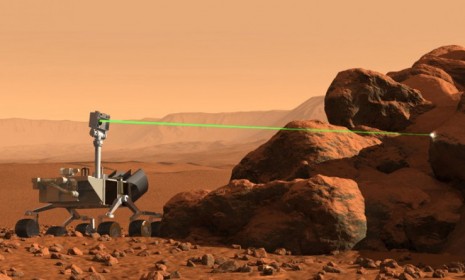The Curiosity rover's nuclear-powered laser
NASA's space lab blasted a small boulder on Mars' surface for the first time Sunday using powerful bursts of rock-vaporizing light

"Pew! Pew! Pew!" says Space.com. NASA's Curiosity rover, which actually hasn't moved an inch since it precariously touched down on Mars two weeks ago, fired its nuclear-powered laser for the first time Sunday. The instrument is one of 10 onboard that rely exclusively on the rover's plutonium power source, and allows scientists back on Earth to a get a better glimpse of what substances make up the Red Planet. A brief breakdown of the $2.5 billion rover's niftiest little gadget:
What is the laser, exactly?
The laser is part of Curiosity's Chemistry and Camera instrument, or ChemCam for short. The laser fires in ultra-brief flashes that last just five one-billionths of a second, but pack more than a million watts of searing power — "enough to turn solid rock into plasma," says Space.com. Over the weekend, the car-sized robot turned the laser's attention to a fist-sized rock that scientists are now calling "Coronation," zapping it for a quick 10-second period.
The Week
Escape your echo chamber. Get the facts behind the news, plus analysis from multiple perspectives.

Sign up for The Week's Free Newsletters
From our morning news briefing to a weekly Good News Newsletter, get the best of The Week delivered directly to your inbox.
From our morning news briefing to a weekly Good News Newsletter, get the best of The Week delivered directly to your inbox.
What's the point of shooting rocks?
Using the laser allows NASA to get a better idea of what kind of minerals make up a substance. While this initial firing was more target practice than anything, the ChemCam can analyze the resulting sparks in a process called "laser-induced-breakdown spectroscopy," or LIBS for short, says Astronomy News. LIBS reads the spectrum of light emitted by the vaporized rock using three different spectrometers. That data is then beamed back to NASA and forwarded to the Los Alamos National Laboratory in New Mexico for studying, says Sebastian Anthony at ExtremeTech.
Who designed the laser?
The laser came to fruition in the Los Alamos National Laboratory, and so far its creators are liking what they see. "We got a great spectrum of Coronation — lots of signal," says the ChemCam project's lead scientist Roger Wiens. "Our team is both thrilled and working hard, looking at the results. After eight years of building the instrument, it's payoff time."
A free daily email with the biggest news stories of the day – and the best features from TheWeek.com
What's next on the agenda for Curiosity?
The rover will take its first baby steps over to a new location nicknamed Glenelg. "First Curiosity will waggle its four steering wheels, and then it will drive straight forward 10 feet, and then make a 90-degree turn and reverse seven feet," says ExtremeTech's Anthony. From there, the rover will make the 400-meter drive forward to Glenelg where it will use its just-fired laser to test new kinds of terrain.
Take a look at an early prototype here:
Sources: Astronomy News, ExtremeTech, Space.com
-
 Political cartoons for December 6
Political cartoons for December 6Cartoons Saturday’s political cartoons include a pardon for Hernandez, word of the year, and more
-
 Pakistan: Trump’s ‘favourite field marshal’ takes charge
Pakistan: Trump’s ‘favourite field marshal’ takes chargeIn the Spotlight Asim Munir’s control over all three branches of Pakistan’s military gives him ‘sweeping powers’ – and almost unlimited freedom to use them
-
 Codeword: December 6, 2025
Codeword: December 6, 2025The daily codeword puzzle from The Week